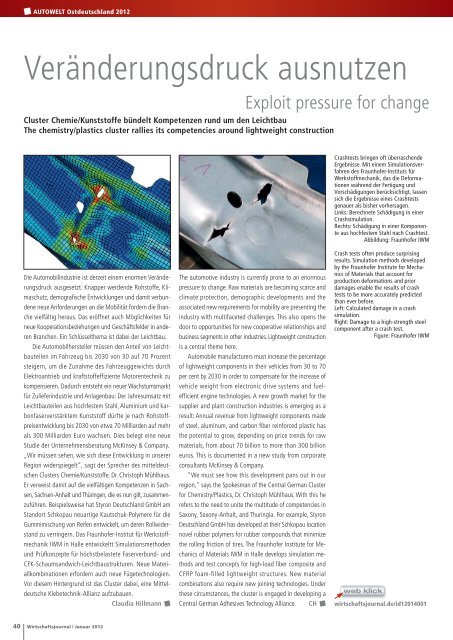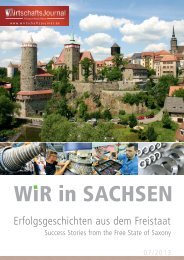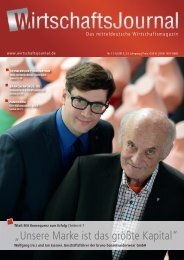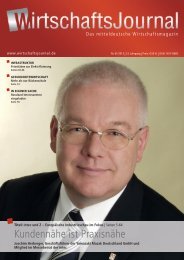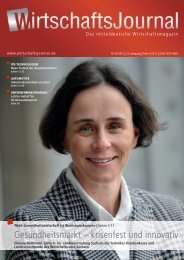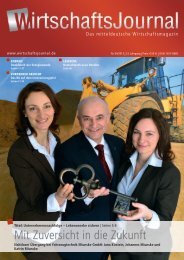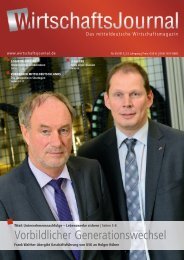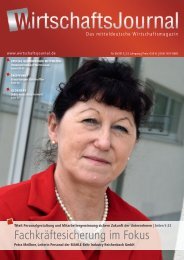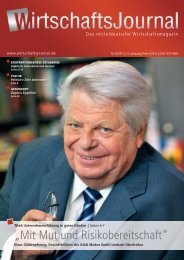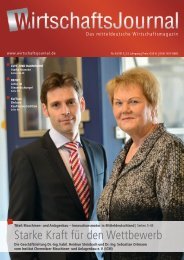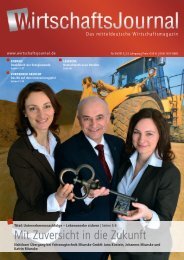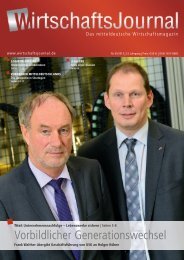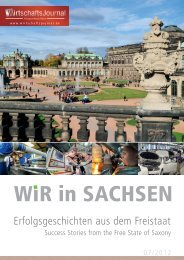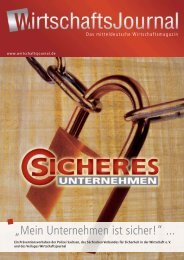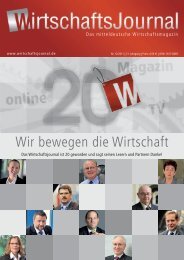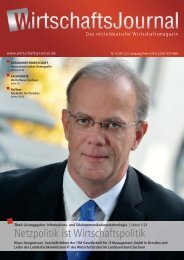„Die Zeichen stehen auf Forschung und ... - Wirtschaftsjournal
„Die Zeichen stehen auf Forschung und ... - Wirtschaftsjournal
„Die Zeichen stehen auf Forschung und ... - Wirtschaftsjournal
Sie wollen auch ein ePaper? Erhöhen Sie die Reichweite Ihrer Titel.
YUMPU macht aus Druck-PDFs automatisch weboptimierte ePaper, die Google liebt.
AUTOWELT Ostdeutschland 2012<br />
Veränderungsdruck ausnutzen<br />
Cluster Chemie/Kunststoffe bündelt Kompetenzen r<strong>und</strong> um den Leichtbau<br />
The chemistry/plastics cluster rallies its competencies aro<strong>und</strong> lightweight construction<br />
Die Automobilindustrie ist derzeit einem enormen Veränderungsdruck<br />
ausgesetzt. Knapper werdende Rohstoffe, Klimaschutz,<br />
demografische Entwicklungen <strong>und</strong> damit verb<strong>und</strong>ene<br />
neue Anforderungen an die Mobilität fordern die Branche<br />
vielfältig heraus. Das eröffnet auch Möglichkeiten für<br />
neue Kooperationsbeziehungen <strong>und</strong> Geschäftsfelder in anderen<br />
Branchen. Ein Schlüsselthema ist dabei der Leichtbau.<br />
Die Automobilhersteller müssen den Anteil von Leichtbauteilen<br />
im Fahrzeug bis 2030 von 30 <strong>auf</strong> 70 Prozent<br />
steigern, um die Zunahme des Fahrzeuggewichts durch<br />
Elektroantrieb <strong>und</strong> kraftstoffeffiziente Motorentechnik zu<br />
kompensieren. Dadurch entsteht ein neuer Wachstumsmarkt<br />
für Zulieferindustrie <strong>und</strong> Anlagenbau: Der Jahresumsatz mit<br />
Leichtbauteilen aus hochfestem Stahl, Aluminium <strong>und</strong> karbonfaserverstärktem<br />
Kunststoff dürfte je nach Rohstoffpreisentwicklung<br />
bis 2030 von etwa 70 Milliarden <strong>auf</strong> mehr<br />
als 300 Milliarden Euro wachsen. Dies belegt eine neue<br />
Studie der Unternehmensberatung McKinsey & Company.<br />
„Wir müssen sehen, wie sich diese Entwicklung in unserer<br />
Region widerspiegelt“, sagt der Sprecher des mitteldeutschen<br />
Clusters Chemie/Kunststoffe, Dr. Christoph Mühlhaus.<br />
Er verweist damit <strong>auf</strong> die vielfältigen Kompetenzen in Sachsen,<br />
Sachsen-Anhalt <strong>und</strong> Thüringen, die es nun gilt, zusammenzuführen.<br />
Beispielsweise hat Styron Deutschland GmbH am<br />
Standort Schkopau neuartige Kautschuk-Polymere für die<br />
Gummimischung von Reifen entwickelt, um deren Rollwider -<br />
stand zu verringern. Das Fraunhofer-Institut für Werkstoffmechanik<br />
IWM in Halle entwickeltt Simulationsmethoden<br />
<strong>und</strong> Prüfkonzepte für höchstbelastete Faserverb<strong>und</strong>- <strong>und</strong><br />
CFK-Schaumsandwich-Leichtbaustrukturen. Neue Materiallkombinationen<br />
erfordern auch neue Fügetechnologien.<br />
Vor diesem Hintergr<strong>und</strong> ist das Cluster dabei, eine Mitteldeutsche<br />
Klebetechnik-Allianz <strong>auf</strong>zubauen.<br />
Claudia Hillmann<br />
40 <strong>Wirtschaftsjournal</strong> | Januar 2012<br />
Exploit pressure for change<br />
The automotive industry is currently prone to an enormous<br />
pressure to change. Raw materials are becoming scarce and<br />
climate protection, demographic developments and the<br />
associated new requirements for mobility are presenting the<br />
industry with multifaceted challenges. This also opens the<br />
door to opportunities for new cooperative relationships and<br />
business segments in other industries. Lightweight construction<br />
is a central theme here.<br />
Automobile manufacturers must increase the percen tage<br />
of lightweight components in their vehicles from 30 to 70<br />
per cent by 2030 in order to compensate for the increase of<br />
vehicle weight from electronic drive systems and fuelefficient<br />
engine technologies. A new growth market for the<br />
supplier and plant construction industries is emerging as a<br />
result: Annual revenue from lightweight components made<br />
of steel, aluminum, and carbon fiber reinforced plastic has<br />
the potential to grow, depending on price trends for raw<br />
materials, from about 70 billion to more than 300 billion<br />
euros. This is documented in a new study from corporate<br />
consultants McKinsey & Company.<br />
"We must see how this development pans out in our<br />
region," says the Spokesman of the Central German Cluster<br />
for Chemistry/Plastics, Dr. Christoph Mühlhaus. With this he<br />
refers to the need to unite the multitude of competencies in<br />
Saxony, Saxony-Anhalt, and Thuringia. For example, Styron<br />
Deutschland GmbH has developed at their Schkopau lo cation<br />
novel rubber polymers for rubber compo<strong>und</strong>s that minimize<br />
the rolling friction of tires. The Fraunhofer Institute for Me -<br />
chanics of Materials IWM in Halle develops simulation me -<br />
thods and test concepts for high-load fiber composite and<br />
CFRP foam-filled lightweight structures. New material<br />
combinations also require new joining technologies. Under<br />
these circumstances, the cluster is engaged in developing a<br />
Central German Adhesives Technology Alliance. CH<br />
Crashtests bringen oft überraschende<br />
Ergebnisse. Mit einem Simulationsverfahren<br />
des Fraunhofer-Instituts für<br />
Werkstoffmechanik, das die Deformationen<br />
während der Fertigung <strong>und</strong><br />
Vorschädigungen berücksichtigt, lassen<br />
sich die Ergebnisse eines Crashtests<br />
genauer als bisher vorhersagen.<br />
Links: Berechnete Schädigung in einer<br />
Crashsimulation.<br />
Rechts: Schädigung in einer Komponente<br />
aus hochfestem Stahl nach Crashtest.<br />
Abbildung: Fraunhofer IWM<br />
Crash tests often produce surprising<br />
results. Simulation methods developed<br />
by the Fraunhofer Institute for Mechanics<br />
of Materials that account for<br />
production deformations and prior<br />
damages enable the results of crash<br />
tests to be more accurately predicted<br />
than ever before.<br />
Left: Calculated damage in a crash<br />
simulation.<br />
Right: Damage to a high-strength steel<br />
component after a crash test.<br />
Figure: Fraunhofer IWM<br />
wirtschaftsjournal.de/id12014001


